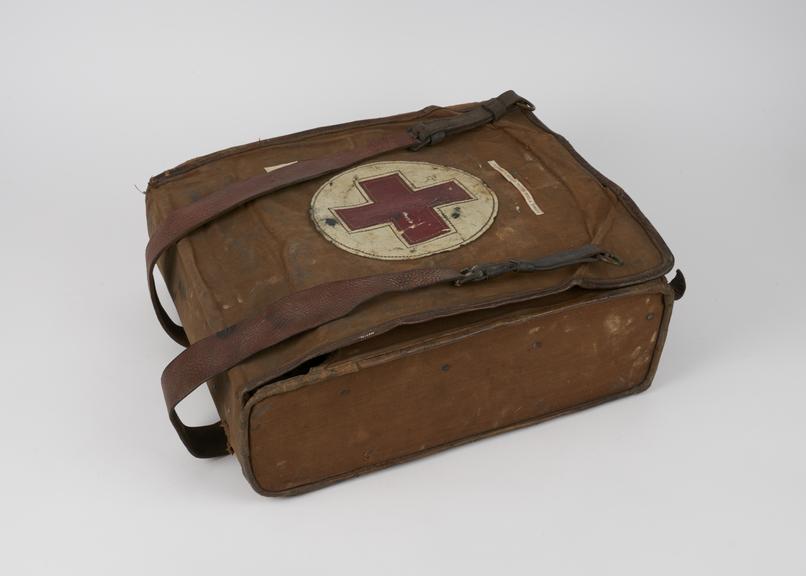2 packets of cotton wool
2 packets of cotton wool, partially unwrapped, paper covering, German, 1914 or 1915


Field medical pannier, canvas, with leather and metal fittings, interior compartments, some with protective metal plates, contents include drug bottles, injection ampoules, dressings, bandages, splints, by Bach and Riedel, German, 1910-1918
The compact medical set was used during the First World War by the German Army. It contains a wide range of equipment needed to treat wounds such as burns and includes dressings, bandages, anaesthetics to numb pain, and sedatives such as opium. Each section of the kit is labelled in German – for example, mull translates to ‘muslin’ or ‘gauze’; verbandpackchen to ‘field dressing’.
This pannier was among large amounts of medical equipment and supplies abandoned by the German Army or captured as their troops retreated in the final months of the war.
2 packets of cotton wool, partially unwrapped, paper covering, German, 1914 or 1915
Roll of elastic bandage on tin dispenser, German, 1910-1918
Tube, clear glass, with metal cap, empty, for chloric ether, Swiss, 1910-1918
Tube, clear glass but stained, for Sublimat, with contents, German, 1917
Two burn dressings, treated canvas, German, 1910-1918
Seven packets of muslin dressing, with three loose rolls of same, paper wrapping, German, 1910-1018
Eight packets of gauze dressing, with four loose rolls of same, paper wrapping, German, 1910-1918
Three packets of gauze dressing, German, 1910-1918
Three glass tubes, containing thread, all in cardboard container, German, 1910-1918
Bottle, clear glass, with leather cap, for turpentine, with contents, probably German, late 19th century
Bottle, clear glass, poor condition, stained and cracked, for valerian tincture, empty, probably German, late 19th century
Clear glass, square-based bottle with cork stopper, covered in leather, and transfer label on the front. Containing approximately 2 ounces of tincture of opium simplex.
Bottle, clear glass, with leather cap, for concentrated camphorated oil (used as a stimulant and pain-killer) with contents, probably German, late 19th century
Bottle, clear glass, with leather cap, for Jodoform (iodoform used as an antiseptic), with contents, proabably German, late 19th century
Hinged orange cardboard box with white and red printed label. Contains 5 glass labelled ampoules. 2 are empty and broken and 3 have contents. The ampoules are sitting in divisions made with card. German product. Label on box states Graudenz. 10 zugeschmolzene Glasrohren zu 0,02 g Morphinum hydrochloricum in Losung von 1 ccm, kelmfrei gemacht 1915' (See note)
Hinged yellow cardboard box with white and red printed label. Contains 10 glass labelled ampoules. 3 are empty and broken and 7 have contents. The ampoules are sitting in divisions made with card. German product. Label on box states 'Sanitatsdepot 10 zugeschmolzene Glasrohren zu 0,02 g Morphinum hydrochloricum in Losung von 1 ccm, keimfrei gemacht' (See note)
Box containing ten ampoules of caffeine, mostly broken, from 17th Army Corps, German, 1910-1918
Box containing twelve ampoules, all intact, for Digipuratum ( a dry preparation of digitalis), German, 1910-1918
Five metal splints, wire mesh, German, 1910-1918
Field medical pannier, canvas, with leather and metal fittings, interior compartments, some with protective metal plates, by Bach and Riedel, German, 1910-1918

